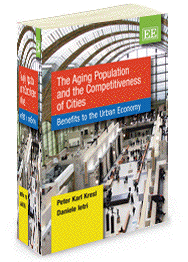The Aging Population And The Competitiveness Of Cities
Benefits to the UrbanEconomy
Peter Karl Kresl , Daniele Ietri
Peter Karl Kresl,Charles P. Vaughan Professor of Economics (Emiritus), Bucknell University, USand President, Global Urban Competitiveness Project and Daniele Ietri, eCampusUniversity, Italy
2010 208 pp Hardback 978 1 84844 212 2
ebookisbn 978 1 84980 693 0

Description
‘The authors deserve credit for “rowing againstthe stream” and asking our attention for the possible contributions of seniorsto the urban economy. Hopefully their book will inspire researchers andstudents to continue exploring this issue in more detail. It may also serve asan eye-opener in urban policy circles as it pays attention to a segment ofsociety that may have been overlooked in this age of “creative city” and“knowledge city” strategies.’
– Marco Bontje, International Journal of HousingPolicy
Contents
While much of the current literature on theeconomic consequences of an aging population focuses on the negative aspects,this enlightening book argues that seniors can bring significant benefits –such as vitality and competitiveness – to an urban economy.
The authors illustrate the ways an agingpopulation can have a positive impact on urban centers, including the move bylarge numbers of seniors from the suburbs to the city, where theirdisproportionate consumption of education and the arts helps rejuvenate citycenters. Given this, the authors conclude that a large and active seniorpopulation has the potential to assist a city in the achievement of itsstrategic economic objectives. The book includes analyses of the effects ofpopulation aging on best practices in 40 cities in the US and EU, withsurprising results, as well as interviews with city officials and leaders.
Academics, researchers and public officials inthe areas of urban development, public policy and aging will find much in thisoriginal approach to interest and provoke debate.
Contents: Preface 1. An Aging Population – GoodNews for Cities? 2. The Demographic Situation in the US and in the EU 3. TheConsequences for National and Sub-national Governments 4. The Consequences forUrban Economies 5. Urban Economies in the US 6. Urban Economies in the EU (exItaly) 7. An Examination of Italian Urban Economies 8. A Look to the Future forPolicy Makers: Best Practices 9. Final Thoughts References Index
